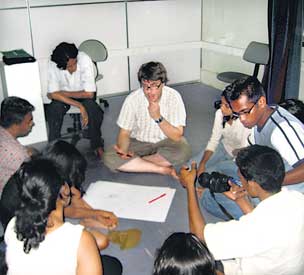
Linking art and people through videoLiving life is an art. This is how Anoma Rajakaruna sees it. “If someone were to record a family sitting in front of a TV, and present this recording at an exhibition, it would be considered a form of art. It is all about where and how the art is placed.” From the conventional oil on canvas art form, we have come a long way in what we have come to define as art. While artists of old captured life as they saw it on stone or canvas, or whatever material that came to hand, art has now evolved to be presented on a screen. Artlink 2008, a collaborative effort by the British Council, the Goethe Institut, Alliance Francaise, the Vibhavi Academy of Fine Arts and the University of Moratuwa is an exchange project, one that has been in operation for ten years. The focus of the programme is to give young artists the opportunity to meet and work with each other, exchanging ideas and expertise. The theme this year is Video Art.
The project aims to, among other things, encourage creativity in developing Video Art and modern media in Sri Lanka through a residential workshop process led by the three European video artists, Elliot Dodd (UK), Florian Thalhofer (Germany) and Olga Kisseleva (France) Over the past few decades, the concept of video art has come into prominence as one of the newer forms of art. It is said to have begun when Nam June Paik used his new Sony Portapak to shoot footage of Pope Paul VI’s procession through New York City in the autumn of 1965. That same day, across town in a Greenwich Village café, Paik played the tapes and video art was born. Video art today is represented by two varieties: single-channel and installation. Single channel works are much closer to the conventional idea of television; a video is screened, projected or shown as a single image. Installation works involve either an environment, several distinct pieces of video presented separately, or any combination of video art today. Sometimes it is combined with other media and is often subsumed by the greater whole of an installation or performance. Contemporary contributions are being produced at the crossroads of other disciplines such as installation, architecture, design, sculpture, electronic art and digital art or other documentative aspects of artistic practice. Artlink 2008 gave 15 Sri Lankan artists and three European artists, all from very different backgrounds the chance to learn from each other while putting together an exhibition of visual art. The themes for this year’s exhibition are: One or more of the four elements: fire, water, wind and rain, Space in between, Mirror, Time and Tropical. Working together has so far proven to be a useful experience for all the participants. “We have learnt to bring all our ideas and theories into practice under one theme, and link them to make the final product something special,” said Anoma Rajakaruna, summing up the experience of all the participants. “We are not certain if the artists will be influenced by one another, or what impact the programme will have on them,” explained Jean-Phillipe Roy, the Delegate General of Alliance Francaise. “The results could present themselves in the near future or even in two to three years time, and there is no telling what those results will be. Either way, the experience of working together in this manner will definitely have an impact on these young artists.” The participants who were chosen through an application process have been divided into three groups, each with vastly different ideas for their presentations. While one group will focus on art in the context of everyday life, the second group gives attention to the perspective an alien would have of life on earth. The third group hopes to present something slightly abstract, an experiment with mirrors and water. Busily working on their presentations and constantly trying to improve them, the participants stayed at the Subodhi Institute of Integral Education in Piliyandala. The never ending challenges of perfecting their exhibits, in addition to learning more about each other and the different cultures that have influenced them, gave them a great deal of exposure to various forms and techniques of art. “This is exactly what Artlink seeks to achieve, says Gill Westaway, Country Director of the British Council. “The programme is not about Europeans imparting their knowledge to the Sri Lankans; rather it is meant to be a mutual exchange of knowledge.” After days of hard work, the participants are now ready to give the public the opportunity to get a taste of Video Art. The exhibition is on at the Goethe Institut, No. 39, Gregory’s Road, Colombo 7 until tomorrow from 9 a.m to 6 p.m. All are welcome. |
|
||||||
|| Front
Page | News | Editorial | Columns | Sports | Plus | Financial
Times | International | Mirror | TV
Times | Funday
Times || |
| |
Reproduction of articles permitted when used without any alterations to contents and a link to the source page.
|
© Copyright
2008 | Wijeya
Newspapers Ltd.Colombo. Sri Lanka. All Rights Reserved. |
